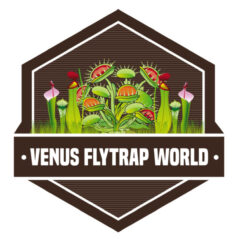Venus flytraps have evolved to be successful predators to survive in very challenging habitats. The different parts of this plant fulfill particular functions such as photosynthesis, mechanical support, reproduction, or feeding.
The main parts of the Venus flytrap are the leaf base, trigger hairs, traps, roots, nectar-secreting glands, special glands, and flowers. The trapping mechanism is one of the most impressive characteristics of the Venus flytrap. There, the trap and trigger hairs play a crucial role in successfully catching prey.
The Venus flytrap or Dionaea muscipula (scientific name) is the most identifiable and better known carnivorous plant. Yet, most people do not know much about them. Today, we will explore the different parts of the Venus flytrap.
Keep on reading to view the Venus flytrap diagram and read an overview on each part of the plant:
- Leaf base
- Trap
- Nectar secreting glands
- Trigger hairs
- Flower
- Special Glands
- Root
If you would like to learn about carnivorous plant care, read this free Venus flytrap care guide where I share how I grow healthy Venus flytraps.
Venus Flytrap Parts Diagram
The diagram below illustrates some very characteristic parts of the Venus flytrap. The image shows some open traps ready to capture prey and some closed ones that are already consuming bugs. Also, it shows a Venus flytrap during the flowering season. Venus flytraps only flower during the spring.
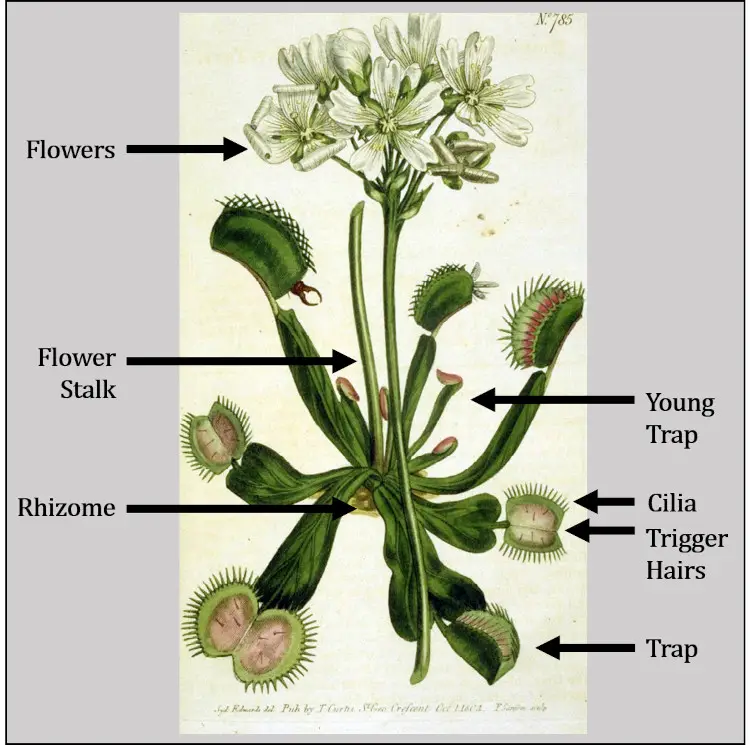
Venus Flytrap Parts
Leaves
Mature Venus flytraps produce three to ten leaves at a time. Each leaf has two concrete parts: the trap and the leaf blade. Inside the trap, we find trigger hairs, nectar-secreting glands, and special glands.
The leaves of a Venus flytrap do not last long periods of time. The traps can be activated a handful of times before the whole leaf starts to wither. But, this is a normal process, as soon as a leaf starts to dry out a new one should spur from the center of the plant. Therefore, it is pretty common to observe dead leaves that have blackened slowly decomposing in the inferior area of the plant.
1.-Leaf Base
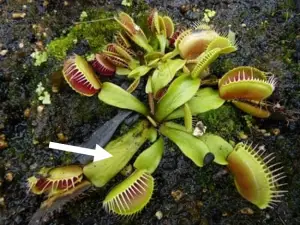
The leaf base extends from the ground and forms the lower part of the leaf. The leaf base is crucial for the photosynthesis process as it receives bright sunlight. The leaf base is heart-shaped as is can be observed in the photo.
When a plant is young, the leaf base stays close to the ground. Once the plant develops, the leaves will grow larger and start standing up. Still, Venus flytraps are not large plants, the maximum height they will reach is a foot.
2.-Trap
Adult Venus flytraps have traps of about 1 inch in length. The trap is made up of two lobes. The exterior of the trap is bright green, and the interior characterizes by a deep burgundy color. Color fading in the traps is usually a warning sign to poor growing conditions. Also, some variations of the plant might not exhibit any red coloring at all.

Each lobe has teeth in the outer line, which are commonly called cilia. The teeth do not bite the prey. Instead, they interlock, close the trap air-tight, and prevent the bug from escaping. The air-tight trap enclosure also prevents bacteria from entering the leaf. Then, molding won’t occur.
The closing mechanism of the traps in Venus flytraps exhibit one of the fastest movements in the plant kingdom. It can catch off guard any potential victim that is lured by sweet nectar. The red color inside the traps also helps the plant lure insects as they confuse the traps with flowers.
In contrary to popular belief, the traps function is not only to capture prey but also to assist in photosynthesis. The Venus flytrap captures prey to supplement their diet, but it is not an essential function. Most of the time the traps will act as standard leaves and help with photosynthesis. In their natural habitat (South Carolina and North Carolina), Venus flytraps are exposed to more than 10 hours of sunlight most of the year.
Fun fact: Scientists are still studying the Venus flytrap trapping mechanism very actively as it exhibits a very unique behavior.
You can learn how to properly feed a Venus flytrap by reading this article: How to Feed a Venus Flytrap.
3.-Nectar-secreting Glands
Venus flytraps have nectar-secreting glands inside their traps. The interior part of the lobes is cover with sweet nectar to attract prey. Venus flytraps lure their prey with sweet nectar and wait patiently.
Insects get confused and believe the red interior of the trap together with the nectar scent are signs of a flower. Then, once a being is inside the trap, the bug will get distracted by consuming the nectar. Meanwhile, the lobes are ready to close as soon as they receive a signal from the trigger hairs.
4-Trigger Hairs
Each trap is made up of two lobes. Each lobe has three hair cells arranged in a triangular pattern [1]. The image below shows the hair cells clearly in the lobes. They are thin and highly sensitive filaments.
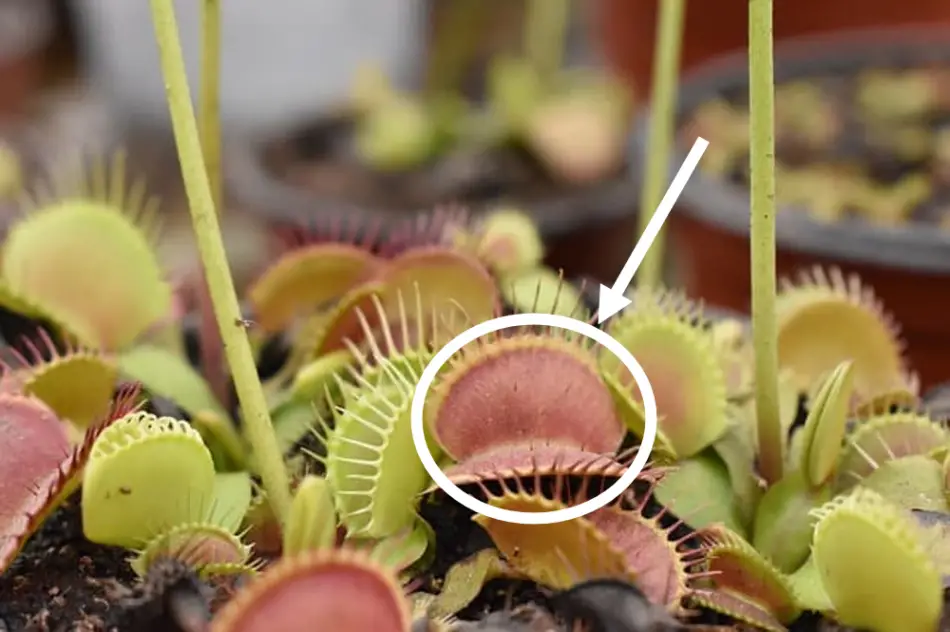
The hair cells are commonly called trigger hairs as they instruct the trap triggering mechanism. The trap only closes when something has touched the trigger hairs two consecutive times within 20 seconds.
The plant developed the double stimuli to avoid closing due to inanimate objects such as rain, a falling branch, or dirt. Venus flytraps spend a significant amount of energy controlling those traps, and they should always try to use their resources efficiently.
You can set the traps by introducing your finger or another object inside the traps. If you stimulate the trigger hairs, the trap will close. Yet, the plant will notice it hasn’t caught prey as the trigger hairs won’t receive any further stimuli once closed. Then, the plant will reopen.
5.-Special Glands
The trigger hairs activate the trapping mechanism to capture the prey. Then, the Venus flytrap secretes enzymes to digest the victim.
“Any mechanical contact with the hairs triggers an electrical signal that spreads across the trap in waves. From the third signal, the plant produces the hormone jasmonate; after the fifth signal, the digestive glands that line the inside of the traps like turf are activated.”- How Venus flytrap triggers digestion, University of Würzburg, Science Daily
The glands secrete enzymes, causing the victim to drown. Digestion is a very long process; it can take several days or even weeks to consume a bug completely. Once digestion is complete, the trap opens up again and exposes the skeleton of the victim. The plant can process the soft parts of the insect, but it won’t be able to digest the rest.
During the digestion process, Venus flytrap extract key nutrients from the prey. They obtain Nitrogen, Phosphorus, Potassium, and other elements to supplement their diet. These elements are essential because Venus flytraps grow in inferior soil that lacks nutrients.
On rare occasions, Venus flytraps can consume animals other than insects and arachnids. For example, they can catch a tiny frog or very small rodents. Venus flytraps can consume these animals. However, they are difficult to capture due to their size and strength.
6.-Flowers
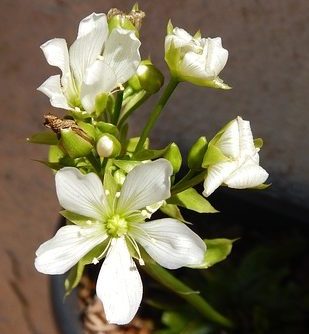
Venus flytraps are perennial plants; and they bloom every year. Venus flytraps undergo dormancy during the winter. After, they return to their original state and start to flourish in the spring.
Venus flytrap flowers are white, and the petals exhibit green veins. The flowers grow as thick cylindrical stalks that end in flower bunches. A single Venus flytrap produces several flower stalks every spring.
Venus flytrap flowers grow a lot taller than their traps. As shown in the picture below, the leaves extend only a few inches above the ground, but the flowers grow a lot higher. Venus flytraps evolved to keep prey and pollinators at two different levels.
The Venus flytrap flowers “adorn the tops of tall stalks that extend beyond the leaves, which prevents pollinators from being trapped and eaten by the plant. (Venus flytraps also have fruit, which comes in the form of round, green pods containing shiny black seeds.)” – Venus Flytraps Have Surprising Pollinators … and They Don’t Eat Them, Elaina Zachos, National Geographic
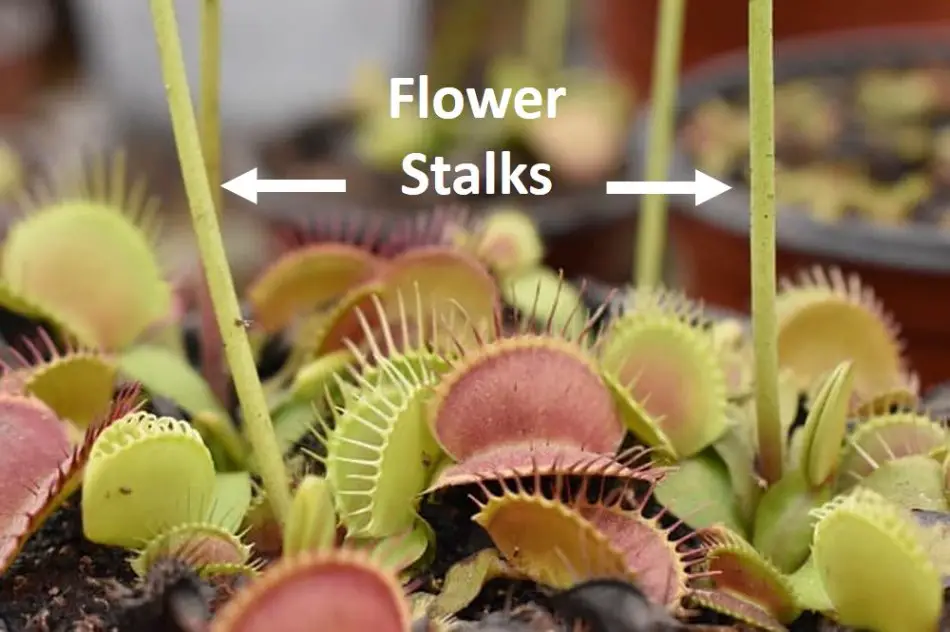
The Venus flytrap spends a significant amount of energy producing the flowers with the hope of reproduction. Owners sometimes opt to cut off the flower stalks before they flourish to save their plant’s energy. Also, some owners decide to manually pollinate their plant and harvest seeds.
You can learn more about Venus flytrap flowers and how to produce seeds with this guide: Venus Flytrap Flower Guide.
Also, there is a unique way to propagate Venus flytraps through flower stalks (learn how it works!).
7.-Roots
The leaves of Venus flytraps spur from a thick rhizome. The rhizome is a horizontal underground stem. Then, the roots extend from the rhizome to several centimeters underground (10-15 cm). They fixate the plant in the humid terrain.
The bulb of the plant is white or pinkish in color and should remain underground. It is very delicate and exposure to sunlight could damage it. Also, the presence of dark spots in the bulb is clear signs of root rot which is caused by fungus or bacteria.
The image below shows several young Venus flytrap before they were potted. All of the bulbs exhibit a healthy white color, and the roots extend through several inches (longer than the plant’s leaves).
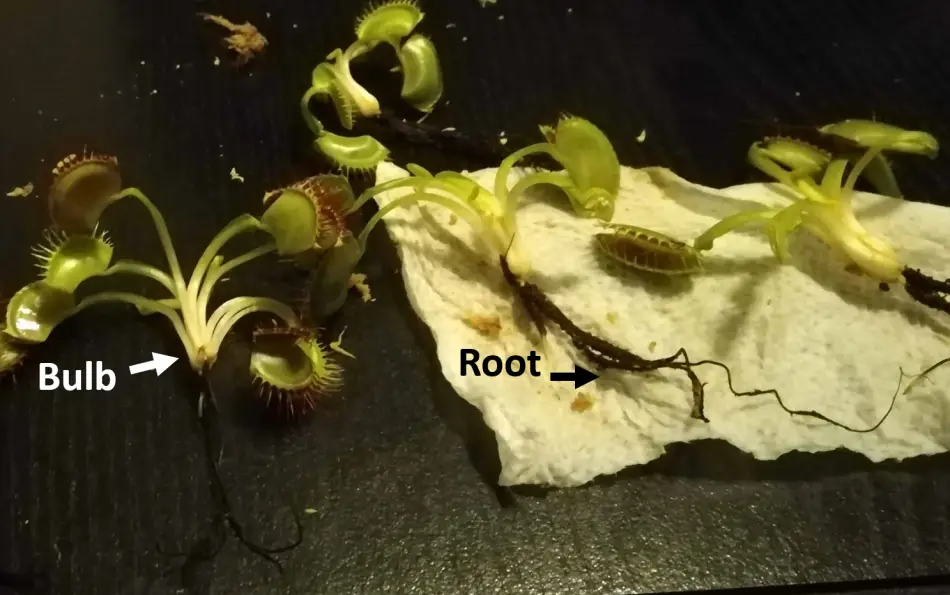
Sometimes Venus flytraps grow substantially and exhibit more than a dozen leaves. Once the plant has acceded the maximum expected number of leaves, then it might be two plants instead of one. The roots of the Venus flytrap can extend in the soil and create a bulb root. Then, a new Venus flytrap grows from the bulb.
Seeds
The seeds are not a part of Venus flytraps, but a life-cycle stage. Still, I thought it would be worth mentioning the seeds for completeness
Venus flytraps produce seeds for reproduction. These plants can reproduce sexually through pollination and asexually via its rhizome. The Venus flytrap can self-pollinate, which means you only need a single plant to produce seeds. However, most growers prefer cross-pollination as the process produces more resilient plants.
During pollination, a pollinating agent (i.e., insect, water, the air, human) transfers pollen from the anther to the stigma of the flower. Then, the fertilized flowers produce seeds to reproduce.
When a flower is pollinated, it withers and it leaves behind the encapsulated seeds. Each flower can produce dozens of seeds. The seeds are tiny and of black color.
Overall Plant Dimensions
Venus flytraps are small plants. To get some perspective of the scale, these are the dimensions of some Venus flytrap parts:
- Horizontally, a Venus flytrap can grow 5 inches in diameter
- The traps can extend upward to about 1 foot
- The trap size for an adult plant is 1 inch
More About Venus Flytraps
Most people associate Venus flytraps to tropical habitats; however, Venus flytraps are native to the wetlands on the East Coast of the United States. There, they are only found in two states: South Carolina and North Carolina.
The most well-known characteristic of Venus flytraps is their trapping mechanism. Venus flytraps do not consume flies exclusively. They can feed themself with any bug attracted by the nectar that is small enough to fit inside a trap.
Some scientists and hobbyists have observed Venus flytraps consuming small frogs or rodents. However, those scenarios are very uncommon. The trapping mechanism is designed to capture bugs, not other animals.
Here are some interesting facts about Venus flytraps:
- Venus flytraps are an endangered species: An increase in poaching practices and urbanization is threatening the specie
- Venus flytraps undergo dormancy every year, which is similar to hibernation in animals.
- You can grow Venus flytrap indoors: The plant develops better in the outdoors, but can easily grow in an indoor setting.
- Most Venus flytraps are green and red, but one variation of Venus flytraps exhibits bright marron colors all around: Akai Ryu (red dragon)
- Venus flytrap require an abundance of sunlight to survive: Optimally they should receive 12 hours of exposure to light
Final Thoughts: Venus Flytrap Parts and Functions
Venus flytraps are fascinating creatures. They have evolved to be successful predators. Thanks to their trapping mechanism adaptation, they have thrived for years in a nutrient-free, poor soil environment.
Even though you might be most impressed by the carnivorous nature of this plant, remember that photosynthesis is still their primary source of energy. Venus flytraps produce their food through photosynthesis. They can survive without catching prey for months or even years because the nutrients they get from insects are only a supplement.
I hope you enjoyed learning about Venus flytraps. And maybe you are even considering growing one at home. I would totally recommend the experience of growing Venus flytraps. You can grow them outdoors if the weather permits or indoors. Make sure to read this guide before you get started. Good luck!
Read the Venus Flytrap Care Guide (with downloadable care sheet) HERE.
Sources
- [1] http://www.plantphysiol.org/content/146/2/694
- https://www.sciencedaily.com/releases/2017/04/170421103741.htm#:~:text=The%20Venus%20flytrap%20digests%20its%20prey%20using%20enzymes%20produced%20by%20special%20glands.&text=Catching%20its%20prey%2C%20mainly%20insects,take%20up%20the%20nutrients%20released.
